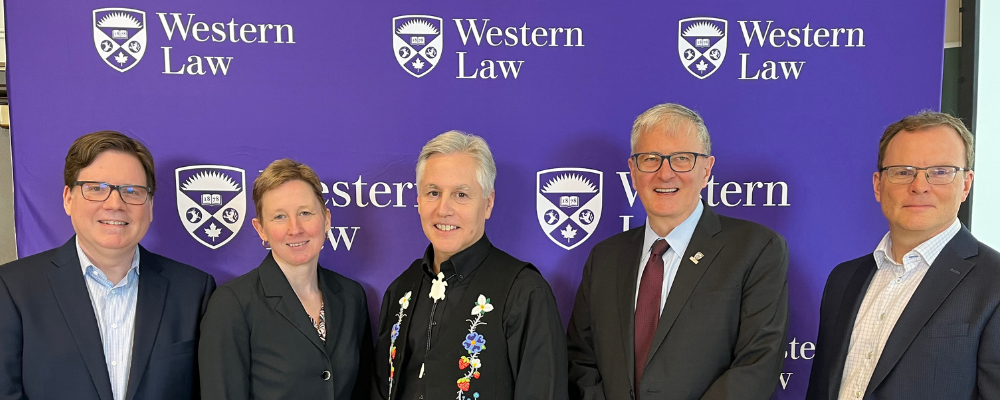Professor John Borrows highlights lessons from Anishinaabe law and constitutionalism at Coxford lecture
April 12, 2024

Photo L-R: Professor Wade Wright, Dean Erika Chamberlain, Professor John Borrows, President Alan Shepard, Associate Dean Andrew Botterell
In the Anishinaabe legal tradition, there’s much more to law than the human world.
At the 2024 Coxford Lecture on March 11, Professor John Borrows, the Loveland Chair in Indigenous Law at the University of Toronto, explored the broad array of forces, including the air, water, fire, rocks, plants, insects, fish, birds, and animals, that are at the heart of Anishinaabe law and constitutionalism.
In his lecture titled Indigenous Law & the More-than-Human World, Professor Borrows highlighted how engagement with Anishinaabe law – and Indigenous legal systems more broadly – can reveal potential gaps and shortcomings in Canadian law and constitutionalism.
Professor Borrows began with a statement of his thesis that animals, plants and other more-than-human forces constitute an important part of Indigenous world views, and that we must work to rebuild our relations with these more-than-human forces to respect and preserve Indigenous legal orders in Canada.
“They are our first law professors, they brought us treaties, and we are related to them through clans and dodems,” said Professor Borrows. “We have often failed to honor our legal inheritance from them. The work ahead involves revitalizing our legal traditions, through restoring our relationships with animals and other life forces on our territories.”
He further elaborated that Indigenous understandings of law are broader than the elements that come to mind when we consider the common law and civil law traditions. He explained that while these systems are an important dimension of law in Canada, they’re an “under-inclusive” way of understanding the law. He added that Indigenous views of law involve considering law as a verb and examining our actions in the context of our more-than-human relatives.
“[Indigenous] law is present in the way groups, including animals and plants, solve problems, resolve conflicts, make collective decisions, create safety, maintain or repair relationships, and act on their responsibilities to one another,” said Professor Borrows. “Law is an activity that can be found, of course, in the human world, but can also be learned if we reason in relationship to what the more-than-human-world teaches us about our possibilities in life.”
Throughout the lecture, Professor Borrows also provided examples of how Anishinaabe People have exemplified these principles, also touching upon how courts have interacted with Indigenous legal orders. One example that he discussed was the Constitution of the nearby Chippewas of the Thames First Nation, which grants legally-protected rights to the more-than-human world.
“It was a true pleasure to welcome Professor John Borrows to Western Law. John is an important Indigenous knowledge keeper, and a global leader in Indigenous law,” said Professor Wade Wright, Co-director of the Coxford Lecture. “He has played a central role in helping us to see the important place that a broader conception of the rule of law in Canada – one that includes a place for Indigenous law – can play in the ongoing project of reconciliation in Canada”.
The Coxford Lecture is generously funded by Western Law graduate Stephen R. Coxford, LLB ’77. Each year, the lecture series brings leading legal thinkers to Western Law to address pressing issues related to the rule of law.






